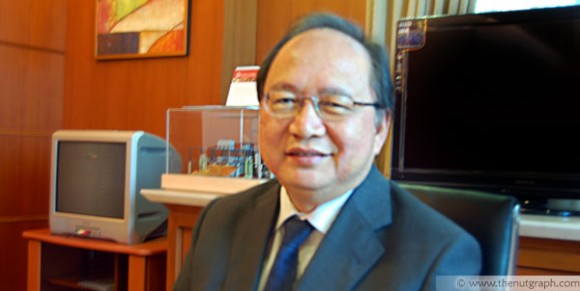
Tan Sri Bernard Dompok (all pics below courtesy of Tan Sri Bernard Dompok)
PLANTATION Industries and Commodities Minister Tan Sri Bernard Giluk Dompok is one of the more outspoken federal government leaders. On a few occasions, especially when it comes to issues affecting Sabahans, he’s spoken up against cabinet positions.
The United Pasokmomogun Kadazandusun Murut Organisation (Upko) president supports the use of “Allah” for Bahasa Malaysia-speaking Christians. He has opposed the Sabah-Sarawakgas pipeline project because it won’t benefit Sabah, where the gas comes from. And he’s not hesitated to put Umno in its place, calling the political party a hindrance to realising1Malaysia.
The Penampang Member of Parliament spoke to The Nut Graph about his early years, his purpose in preserving missions schools, the Kadazandusun language, and what being Malaysian means in an interview on 28 Oct 2010 in Putrajaya.
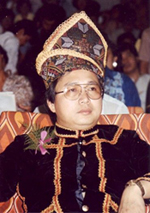
The young politician at an event in the 1980s
TNG: When and where were you born?
Bernard Dompok: 1949. In a kampung house, delivered by a kampung bidan, in Kampung Putaton in Inobong, Penampang.
Is that where you grew up?
Yes, partly. My father worked for Shell in Brunei, so I spent an early childhood there up to primary three. I went to school at St Michael’s [in] Seria. When my [family returned] to Sabah, I continued Standard 4 in another school also called St Michael’s, in Penampang. In those days in Penampang, there was only school up to Form 3. For the upper forms you had to go to the school in Kota Kinabalu (KK) run by the La Salle brothers. I did, and lived at the boarding house there.
What are some memories of your childhood in these places?
In Seria, Brunei, I remember going to school with Ibans, Chinese, Indians and Malays. It was a Catholic mission school and there was a mix of students.
My family’s stay there was actually cut short because my father was asked by my grandmother to come back to Sabah due to the political situation in Brunei at the time. Brunei was asked to form Malaysia together with Sabah and Sarawak, but Brunei opted out in the end. [In the run up to that,] there was the Brunei or Azahari Rebellion that opposed joining the Federation of Malaysia. It wasn’t the best of times to be there.
One other thing that struck me about school in Brunei was that the use of English was heavier. Back in Penampang, Kadazandusun was spoken more because 90% of my classmates were Kadazandusun. There were also a few Chinese. There were no Malay students at St Michael’s in Penampang, but there were later on at La Salle school in KK. At that time, Malays wouldn’t call themselves Malays, they would call themselves Bajau or Brunei Malays. Actually in Sabah, there were no Malays. You were either Bajau, or Murut, or Orang Sungai. The closest to Malays were the Brunei Malays because they were originally from Brunei before settling in Sabah.
In history, that part of Sabah was under the Brunei sultanate. [In my early days] in politics, I remember campaigning in the Bajau and Brunei Malay area, and they still put up the picture of the Sultan of Brunei alongside the Yang di-Pertuan Agong’s picture. People there still had some strong sentiments for the Brunei sultanate at the time.
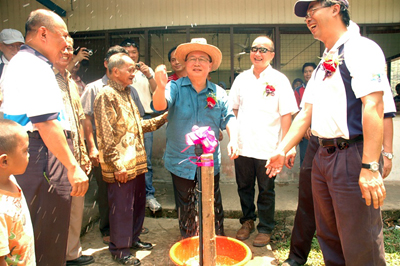
Officiating the launch of piped water supply to Kampung Timpangoh Sugud, Penampang
What about memories of growing up in KK at the La Salle brothers’ school?
At La Salle, we had Chinese, Kadazandusun and Muslim students. I stayed in the boarding house so there were a lot of opportunities to make friends.
I feel the character of mission schools has changed, and that is what I am trying to fight for, to go back to the position where the mission schools were given the type of recognition they once had. A lot of our leaders now would not have received an education without the mission schools. These schools need their own autonomy. Mission schools provided wholesome education and they were not there to propagate. In the classes I had, my Muslim classmates stayed Muslim, and Buddhist students stayed Buddhist. There was a spirit of excellence, dedication and discipline. You could feel the teachers’ dedication. The missionaries inculcated this type of spirit.
Last time, the school principals and teachers were picked by the missionaries, and the missionaries paid the teachers themselves. Later on when it grew burdensome, they asked the government to pay the teachers, and because of that the schools became government-aided schools under the Education Ministry’s full control.
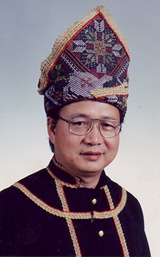
Dompok in the 1990s
Can you trace your ancestry?
I don’t know. It’s still very debatable. There are suggestions that the Kadazandusun people came from the Asian mainland. One place suggested is Yunan. Others have suggested that they came from the Philippines. I think there’s a lot of room for this to be anthropologically researched. There are some foundations looking into it but the real hard anthropology work has not been done. There is nothing authoritative and conclusive.
That is why you have legends. Like the Harvest Festival where people think the Unduk Ngadau is a beauty contest only, but it’s more than that. Unduk Ngadau actually symbolises Huminodun, who was sacrificed to become food for the people during a famine.
Is there any idea as to when the first Kadazandusun people arrived in Sabah?
I don’t know, but there is a place in Ranau, called Nunuk Ragang, which is said to be the first place where the Kadazandusun people settled.
What do you know about your parents lineage?
My father and my mother were from different villages in the same district. Both my parents are Kadazandusun but even within the same group of people you can have different dialects. My mother was from a village on the lower part of the Moyog River, and my father from upriver.
In Penampang, there are a lot of Kadazandusun people with Chinese blood. They cannot speak Chinese but can speak Kadazan.
But now, the majority of children speak in Malay. There is concern that children will lose the Kadazandusun language. That is why I’ve worked hard for it to be taught in school. Universiti Pendidikan Sultan Idris is going to offer it as a minor. This year, Kadazandusun language is also going to be offered as an SPM subject. Two years ago, it was a PMR subject.
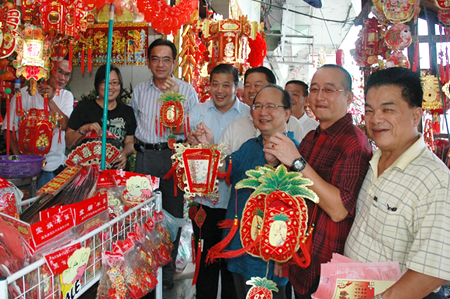
Meeting constituents on a walkabout during Chinese New Year in 2010
I didn’t know that. This might be news to those in west Malaysia.
You see, the trouble is, East Malaysia and Peninsular Malaysia are different worlds. Newspapers are west Malaysia-oriented. In the minds of west Malaysians, Malaya is Malaysia. To such an extent that up to today, when some people arrive in KK, they say, “Oh, I’ve just come from Malaysia to Sabah”.
How do you connect your heritage with being a Malaysian?
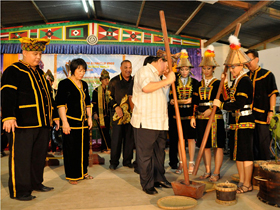
At Upko Papar’s celebration of Kaamatan, or the Harvest Festival, in 2010.
The country has to recognise such diversity and use it as a heritage. This is the basis on which I fight for the inclusion of the Kadazandusun language in schools. If we don’t, we will lose a cultural heritage. We are supportive of the national language, but that doesn’t mean you have to allow a cultural heritage to be lost forever.
In the constitution, Article 153 specifies the Malays and the natives of Sabah and Sarawak. The natives are mentioned and given equal footing. So it is Malays and natives, not Malays full stop. What is happening today is, I think, some people assume it is Malays, full stop. They don’t continue.
So this is what I’m trying to fight for, and that’s why we have a cabinet committee on the natives of Sabah and Sarawak. The prime minister is the chairperson and I chair the technical committee. One of the things being done is to get the native court system to be established on, probably, the same footing as the civil and syariah courts. So for example, a marriage between the natives of Sabah can have recourse in the native court and not the civil court.
Are there any aspects of your Malaysian identity that you struggle with?
What is the Malaysian identity? As far as I’m concerned, I’m a Kadazan Malaysian, just like the people in the US who are Italian American, African American or Asian American. The operative word is “American”. And in our case, “Malaysian”. And being Kadazan, or Chinese, or whatever, is an adjective, right? It describes the noun. “Malaysian” is the noun. The race doesn’t stand alone. It describes the identity.
So my Kadazan-ness describes my identity as a Malaysian. The noun is “Malaysian”. I don’t agree with saying “Malaysian Chinese”. It should be Chinese Malaysian, Indian Malaysian, Iban Malaysian.
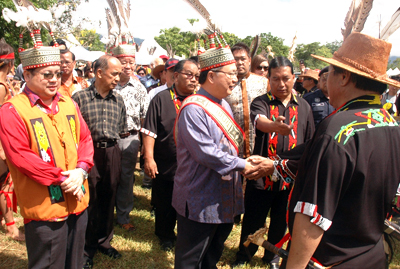
At a Murut community event in 2009
What kind of Malaysia do you want for yourself and future generations?
I want a Malaysia in which everyone — and this is what I’ve been trying to get inserted into our Barisan Nasional manifesto — where everybody who is Malaysian is treated the same under the Malaysian sun. Implementation of the constitution must not be selective. As I said, [recognition of] the Malays and the natives of Sabah and Sarawak, must be one sentence.
Therefore, I would like to see Malaysia implement its policies based on its diversity. Nothing less. The government is a government for all Malaysians. The rulers are rulers for all Malaysians and not just the Malays. So therefore, my right as a Christian in this country also has to be protected by the ruler, because he’s my ruler. He’s my Agong.
courtesy of Nut Graph


West is west and East is East
ReplyDeleteand NEVER the twain shall Meet!
We want our own independent Sarawak free from Malayan domination!